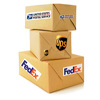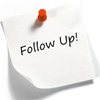A sales follow-up email is an easy method to contact potential customers and to try to sell them things. So why don't most of them work well (i.e. lead to sales)?
The reason why is that most of them try too hard to sell. This may seem strange to say because the purpose of them is to convert a potential customer into an actual one. And it is, but not necessarily straight away.
Ask yourself how many times have you bought something directly after receiving an email from a company you've had little contact with before? If you are like most people, the answer will probably be never.
Creating trust
That's not to say that you can't promote your company's products (and try to get a sale) in a sales follow-up email. You can, but it shouldn't seem as the only or main purpose why you are sending the person the email.
A good sales follow-up email is used to build up both a relationship and trust. There are various ways you can do this, but one of the best is to provide the potential customer with something which they'll be interested in or useful.
After you have had some engagement with the person, you can then start to push for a sale.
In this online exercise (with a quiz at the end) on writing follow-up emails, you'll see three examples of different types of sales follow-up emails you can send to potential customers. In these you'll find vocabulary and phrases you can use yourself and learn what kind of things to include in your own follow-up emails.
To find out what makes a good sales follow-up email, read our 'How to write a sales follow-up mail' article/guide.
To both see an example and learn how to write a follow-up email to existing customers, do our online exercise on 'writing a sales follow-up email to people who have bought things from you'.
Exercise & Examples:
Below are three examples of follow-up emails. The first two are emails for potential professional/business customers and the last is to a potential non-business customer. Look at all three emails and think about what they are trying to do and how they are doing it.
From the context, think why the vocabulary/phrases in bold are being used. Then do the quiz at the end to check if you are right.
Email 1
Hi Sally,
Thank you for speaking with me yesterday. I was wondering whether you've thought of any more questions about our service that I could answer for you?
I appreciate that you are very busy, but if you could reply to me (either by email on mwallace@pudseyinfo.com or by phone on 01262 3417197) it would be much appreciated. If you're too busy, I'll contact you by phone in a couple of days.
Regards,
Morven Wallace
Sales Executive
Pudsey Info inc.
P.S. Samsang plc has just purchased the same service that you are interested in buying.
Email 2
Good Morning Jeff,
I hope you are well. We spoke about a month ago about your interest in improving your customer services department's computer system.
I've been thinking about your particular situation and I've pulled together some articles and information on improving customer service performance which I think will be of great benefit to you. One of the articles I found is on best practices for tracking customer calls (see below):
www.ionsystems.com/guides/call_tracking.html
If you'd like, I can send you the rest of the articles and information by email? Just give me a call (on 07956 45274906) or send me an email (to i.flynn@ionsystems.com).
I look forward to hearing from you.
Regards,
Ian Flynn
Sales Manager
Ion Systems inc.
Email 3
Hi Peter,
You recently downloaded a 'buying car insurance guide' from our website (loanfinder.com). I'd just like to confirm that you've received it and found it very useful?
We've also produced a number of other guides for buying other types of insurance products (life, home etc...). Click here to see the guides.
By the way, have you heard that we've got an excellent offer on car insurance from Live Safe (only available on our website)?
If you buy before Tuesday 25th May, you'll get a 15% discount. Plus, we'll add a further discount of 10% onto the offer. So that means that you're going to save 25% on any insurance product you buy through our website for Live Safe. Click the below link and take advantage of this superb offer:
www.loanfinder.com/offers/live_safe.html
If you haven't received your guide or have any questions, don't hesitate to contact me (Gary Tate) by email (gary.tate@loanfinder.com) or by phone (0895 657 1004).
I look forward to hearing from you.
Regards,
Gary Tate
Sales Executive
Loanfinder.com
P.S. To receive advice and hear about insurance promotion and offers, follow us on Facebook or Twitter.
Now do the QUIZ below to make sure you know how to write this type of email.
 How to write a sales follow-up email after a customer order
How to write a sales follow-up email after a customer order
 How to write any good sales follow-up email article
How to write any good sales follow-up email article
Quiz:
Below is a definition/description of each of the words/phrases in bold from the above text. Now choose the word/phrase from the question's selection box which you believe answers each question. Only use one word/phrase once. Click on the "Check Answers" button at the bottom of the quiz to check your answers.
When the answer is correct, this  icon will appear next to the answer. Click on it to find extra information about the word/phrase (e.g. when, where and how to use etc...).
icon will appear next to the answer. Click on it to find extra information about the word/phrase (e.g. when, where and how to use etc...).
Practice
Now that you understand the new vocabulary, practise it by creating your own emails with the new words/phrases.
Follow us on  or on Twitter
or on Twitter 




 icon will appear next to the answer. Click on it to find extra information about the word/phrase (e.g. when, where and how to use etc...).
icon will appear next to the answer. Click on it to find extra information about the word/phrase (e.g. when, where and how to use etc...).
